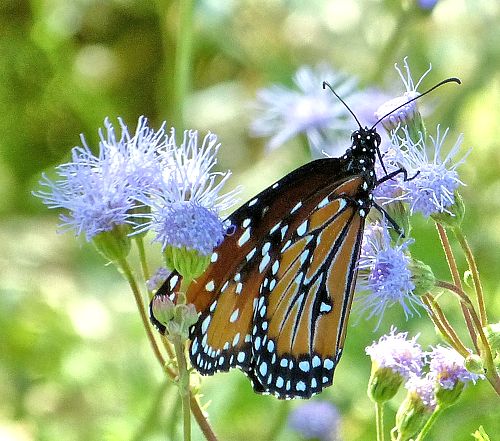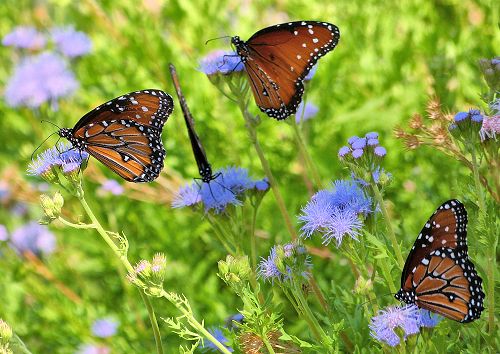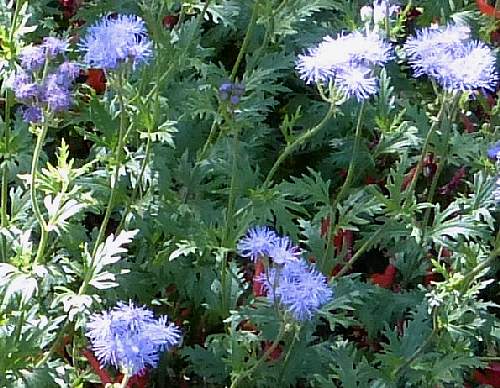Growing Conoclinium greggii:
Gregg's Mistflower
Description
Form: Herb.
Lifespan: Perennial.
Growth rate: Moderate.
Mature Size: 1-2' (30-60cm) high.
Flowers: Each flower head is rayless and has many blue to purple disc florets with long threadlike stigmas that provide an overall fluffy appearance.
Bloom: Spring through fall.
Fruit: Each floret produces a tiny seed (cypsela), tufted at one end.
Leaves: Green, finely divided.
Stems: Long, weak, green to brownish.
Roots: This plant spreads by rhizomes to form colonies. It is not overly invasive and is easily eradicated.
Wildlife: The flowers attract butterflies and bees. Male Queen and Monarch butterflies are drawn to this plant and use a chemical in its nectar to attract females. It is most attractive to butterflies when it is partly shaded. This plant is browsed by mammals; enclose within a rabbit proof fence 18" (50cm) high.
Toxic / Danger: No.
Origin: Arizona through Texas and Mexico.
Form: Herb.
Lifespan: Perennial.
Growth rate: Moderate.
Mature Size: 1-2' (30-60cm) high.
Flowers: Each flower head is rayless and has many blue to purple disc florets with long threadlike stigmas that provide an overall fluffy appearance.
Bloom: Spring through fall.
Fruit: Each floret produces a tiny seed (cypsela), tufted at one end.
Leaves: Green, finely divided.
Stems: Long, weak, green to brownish.
Roots: This plant spreads by rhizomes to form colonies. It is not overly invasive and is easily eradicated.
Wildlife: The flowers attract butterflies and bees. Male Queen and Monarch butterflies are drawn to this plant and use a chemical in its nectar to attract females. It is most attractive to butterflies when it is partly shaded. This plant is browsed by mammals; enclose within a rabbit proof fence 18" (50cm) high.
Toxic / Danger: No.
Origin: Arizona through Texas and Mexico.
Cultivation and Uses
USDA hardiness zones: 7-10.
Heat tolerant: Yes.
Drought tolerant: Yes.
Sun: Full sun to part shade. More flowers are produced in part shade, especially afternoon shade, during the hottest months of the year.
Soil: pH 6.6-7.8 (neutral to slightly alkaline). This desert plant is often found alongside dry stream beds.
Water once established: Water every 10 days to two weeks in part shade. Water weekly in full sun.
Mulch: Organic mulch or small rock pebbles are appropriate.
Prune: Cut back in winter or cut to the ground after freezing temperatures are past. Pull out to eradicate.
Litter: Low.
Propagation: Seed or root division. This plant reseeds in favorable conditions.
Uses: Butterfly garden.
USDA hardiness zones: 7-10.
Heat tolerant: Yes.
Drought tolerant: Yes.
Sun: Full sun to part shade. More flowers are produced in part shade, especially afternoon shade, during the hottest months of the year.
Soil: pH 6.6-7.8 (neutral to slightly alkaline). This desert plant is often found alongside dry stream beds.
Water once established: Water every 10 days to two weeks in part shade. Water weekly in full sun.
Mulch: Organic mulch or small rock pebbles are appropriate.
Prune: Cut back in winter or cut to the ground after freezing temperatures are past. Pull out to eradicate.
Litter: Low.
Propagation: Seed or root division. This plant reseeds in favorable conditions.
Uses: Butterfly garden.
Comments
This plant is a member of the Daisy family (Asteraceae). Look carefully, and you will see four Queen butterflies in the center picture.
Do you have additional information or a different experience for these plants that you would like to share? Email info@GardenOracle.com. All contributions are welcome and appreciated.
This plant is a member of the Daisy family (Asteraceae). Look carefully, and you will see four Queen butterflies in the center picture.
Do you have additional information or a different experience for these plants that you would like to share? Email info@GardenOracle.com. All contributions are welcome and appreciated.



Latest update: September, 2024
© 2008-2025 by GardenOracle.com

